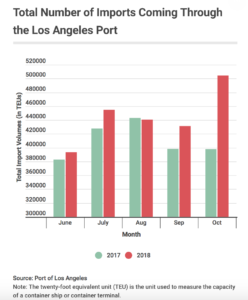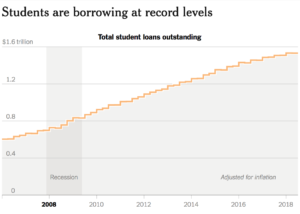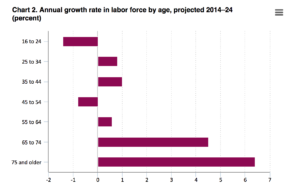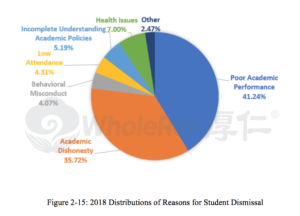While waiting for hours to get called for a shift outside the dispatch hall at Wilmington, Calif., Rafael Ochoa, a 37-year-old freelance or “casual” longshore worker at the Port of Los Angeles, remained uncertain about the future work volume amid the headline-grabbing trade dispute between China and the U.S.
“It is all about the economy, if the economy f*&%s up, we are not working, that is just how it goes.” Ochoa said. “We are already struggling.”
The neighboring ports of Long Beach and Los Angeles are a key entry point for goods imported to the U.S., with 40 percent of all imports coming through the gateway of San Pedro Bay, Nick Vyas, executive director of the Center for Global Supply Chain Management at the USC Marshall School of Business, said. “We are a huge network entry point of the Asia Pacific, especially stuff coming from China,”
Even though the two countries have reached a truce after the 2018 G-20 summit in Buenos Aires, Argentina, official announcements regarding the timeline and de-escalating plans are yet to be published. Currently, the White House has imposed tariffs on $250 billion worth of Chinese imports – 25% on $50 billion worth and 10% on the rest. To retaliate, Beijing levied tariffs on $60 billion of American goods.
According to the Port of Los Angeles, it handled $284 billion in trade during 2017, while trade with China and Hong Kong accounted for more than half of its total cargo.
As the largest container port in North America, it generates colossal economic activities: 147,000 jobs in Los Angeles, 1.6 million jobs throughout the country, 41 percent of West Coast’s market share, and 18 percent of the national market share, according to statistics published by the port.
If the head-to-head trade confrontation continues, the Port of Los Angeles is expecting to see negative impacts on up to 20 percent of trade values in the fourth quarter, Philip Sanfield, a spokesperson of the port, said.
Besides financial losses to the port, the trade war could result in potential human toll for workers on the waterfront.
After his 12-year journey of being a part-time longshoreman, Ochoa is still far away from earning his chance to be part of the union. By getting three to four shifts on a weekly basis, Ochoa could bring home between $35,000 to $55,000 a year, depending on how much he works and what job he gets. “The pay here is good, plus if you don’t show up they don’t get mad at you.”
However, the everyday wait is horrendously long. “It could be three hours in the morning, three hours at night.” he said. “We have no life outside this, we just have to be here.”
Without the union’s shield, casual workers secure far fewer shifts than full-time workers. Seven days a week, they queue up for a chance to get leftover assignments that are not taken by the union members. “We don’t get to choose, they get to choose,” Ochoa said.
In the face of the ongoing trade-war tensions, Ochoa expressed his frustration over the uncertainty in a profanity-laced response to questions about his future.
Ochoa said the job amount in the upcoming months could be reminiscent of the situation in 2009. He and his colleagues had no choice but to leave the dispatch hall with no jobs when the economy went into a tailspin. “We would show up for three months straight, and finally we took three months to get out once,” he said.
Despite the holistic impact on economic activities on the dock, casual longshoremen would bear the brunt of the tug of war between the U.S. and China as they are at the bottom of the dispatch system. “Definitely all the casuals, but I think some regular will also be affected.” Ochoa said.
Regarding the massive trade with China, the endless uncertainty about the trade war could have huge implications on the entire country, not just Los Angeles.
Vyas said consumers would start to feel the slings and arrows of tariff ramifications in six months. “The cost of goods will be much higher because obviously of the companies continue to produce goods in China, they will get higher taxes.”
However, since tariffs became the hot-button issue for manufacturers and distributors earlier this year, the Port of Los Angeles has experienced some good months compared to 2017.
With Chinese shippers pushing hard to swarm products into the U.S. before the tariffs were in place, the volume of total imports coming through the port rose 2.8 percent and 6.3 percent year-on-year in June and July respectively, port statistics show.
Although import volumes recorded a 0.5 percent year-on-year dip in August following the onset of retaliatory tariffs between the two nations, the numbers jumped 8.3 percent and 26.7 percent in September and October respectively from a year prior, according to the data published by the port.
Vyas does not think the trade volume at the port will be affected under the tariff pressure as Chinese manufacturers are quickly investing and divesting out of China in response to Trump’s trade policy.
“This dispute creates an urgency to open up factories in different parts of the world, and stuff that was made in China is now made in Malaysia. It is very easy for them to create the capacity and start manufacturing.” he said.
While no solutions to the trade disputes are being seen in container shipping companies, Sanfield said negotiable settlement instead of tariffs would be good to global trade, not only for the Los Angeles port.
“I think it is interesting to see who is going to blink first and who is going to say it is time to stop this childish game and adopt discussion on the table and finalize it,” Vyas said. “There will be give and take.”






